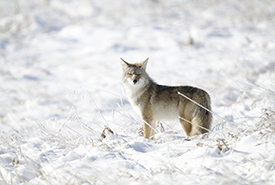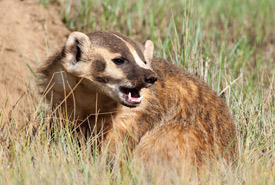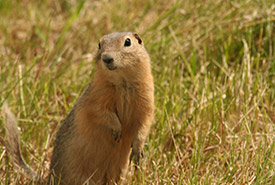Unlikely animal pairings: Part one

Coyote (Photo by Paul Turbitt)
Have you ever seen the internet stories entitled “unlikely animal friends”? Usually, they are stories about a dog and a cat that sleep together, but sometimes they are about more exotic couplings, like an ostrich and a giraffe, or a dog and an elephant. If you are like me, these stories melt your heart with their cuteness. Often these stories of odd animal pairings come from animals that have been placed in zoos or nature rehabilitation centres.
Unlikely animal pairings aren’t just a human creation though. Sometimes, wild animals find themselves working alongside other species for the mutual benefit of both species. Working together can increase the likelihood of a successful hunt for both parties, increase effectiveness and save energy. In the long run, they both benefit, but not necessarily on the same hunt.
One of the most interesting cases of a strange animal pairing in nature is the American badger and coyote. Both animals live on the prairies, and while they share an ecosystem, they typically ignore each other. With similar diets, it would seem like the two would be competitors fighting for what are often limited hunting resources, but sometimes they also work together.

American badger near its burrow (Photo by Gerald A. DeBoer/Shutterstock)
It is well documented across the North American prairies that badgers and coyotes sometimes team up with each other to hunt rodents. Coyotes often hunt in packs, but badgers are typically solitary animals. Although different pairing numbers have been recorded, it is most common to see one badger and one coyote team up. In very rare cases, as many as three coyotes have been seen hunting with a badger. One reason why the animals might team up is that their prey have different instinctual responses depending on the type of predator it sees.
If a rodent such as a prairie dog or ground squirrel sees a coyote, its first response is to dive into its burrow where the coyote won’t be able to follow it. Coyotes will dig after a rodent, but they rarely see much success. The response when rodents see a badger is very different. Instead of running into the burrow, they stay above ground and use their superior speed to outrun or dodge the badger. Any slip-up by the prey means death, but more often than not, these strategies work for prairie rodents.

Richardson's ground squirrel (Photo by NCC)
So what happens when the badger and the coyote start working together? If the rodent sees the coyote first, the rodent will dive into its burrow. The badger uses its steel-like front claws to dig into the burrow to capture the rodent. The badger digs so fast that dirt and debris get sent into a cloud behind its smaller hind legs. So much debris gets sent into the air that the badger has evolved a special set of eyelids that keep dirt and dust out of its eyes.
On the other hand, if the rodent chooses to stay outside of the burrow, it has even less of a chance of survival because the quick coyote can use its speed and size to leap onto it. One of the primary reasons that most prairie rodents use burrows is because coyotes and other predators are just too fast to outrun on the open prairie.
With both a badger and coyote hunting, prey does not have much of a chance and needs to act fast to either outrun or outsmart the hunting pair. This is where the hunting pair gets another advantage. The rodent may take an extra moment to determine how to try and escape the two predators, because its normal instincts aren't sure what to do. It may be less than a second, but that can mean the difference between life and death.
It turns out that while the coyote and badger may help each other hunt, they aren’t much for sharing. While hunting together increases the likelihood of one of the predators finding a meal, once one of the hunters catches its prey, the friendship is over. The successful hunter gets to enjoy the spoils of the hunt, while the other is left to keep searching for food.
The coyote-badger pairing is just one example of animals that seem unlikely to work together. Cooperation is seen all across the animal kingdom.
Check Land Lines on February 26 for part two of “Unlikely animal pairings.” In this unlikely pairing, one species definitely benefits more than the other.


